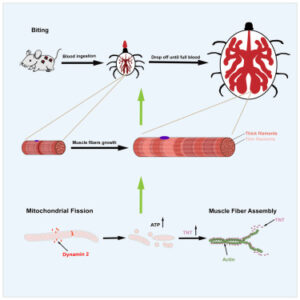 I am regularly awestruck by the feats accomplished by our fellow animals. Here’s one that might not seem particularly praiseworthy: eating your body weight in a single meal. This is regularly achieved by ticks, and that’s a second reason you might want to stop reading, but hear me out. A tick gorges itself on blood (perhaps yours) until it has ballooned to at least ONE HUNDRED TIMES its pre-meal body weight. How is this even possible? Specifically, how does this animal’s gut accommodate the vast expansion that results from a blood feast?
I am regularly awestruck by the feats accomplished by our fellow animals. Here’s one that might not seem particularly praiseworthy: eating your body weight in a single meal. This is regularly achieved by ticks, and that’s a second reason you might want to stop reading, but hear me out. A tick gorges itself on blood (perhaps yours) until it has ballooned to at least ONE HUNDRED TIMES its pre-meal body weight. How is this even possible? Specifically, how does this animal’s gut accommodate the vast expansion that results from a blood feast?
A new paper in Cell Reports asked that question, focusing on the muscles of the tick’s gut. The authors looked at two interesting consequences of feeding in the gut: proliferation of gut stem cells, and fission (splitting) of mitochondria. Stem cell proliferation seems a reasonable path toward the necessary expansion of the gut, but when the authors inhibited that process, ticks happily gorged themselves to the same extent. But inhibition of mitochondrial fission disrupts feeding, and the authors show why: more mitochondria are needed for ATP, which is needed for upregulation of a muscle protein called troponin T (delightfully abbreviated TNT). Experimental reduction of TNT expression inhibits muscle function, and ruins the tick’s meal. Sad.
Mitochondrial fission regulates midgut muscle assembly and tick feeding capacity
In Cell Reports, 22 April 2025
From the group of Jingwen Wang at Fudan University
Snippet by Stephen Matheson
Image credit: graphical abstract from Zhong et al. (CC BY-NC)